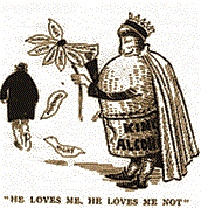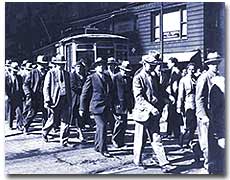46b. The Fight Against "Demon Rum"

Prohibition Political cartoons, both for and against, sprouted up during the 1920s
Saloons were closed, bottles were smashed, and kegs were split wide open. When the states ratified the Eighteenth Amendment in 1919, the manufacture, sale, and transportation of alcoholic beverages was outlawed. Protestant ministers and progressive politicians rejoiced and proclaimed a holier and safer America. It was predicted that worker productivity would increase, families would grow closer, and urban slums would disappear. Yet for all its promise, prohibition was repealed fourteen years later, after being deemed a dismal failure.
Advantages to Prohibition
In fairness, there were advantages to prohibition. Social scientists are certain that actual consumption of alcohol actually decreased during the decade. Estimates indicate that during the first few years of prohibition, alcohol consumption declined to a mere third of its prewar level. Although no polls or surveys would be accurate, health records indicate a decrease in alcoholism and alcohol-related diseases such as cirrhosis of the liver. Family savings did increase during the decade, but it was difficult to determine whether the increase was due to decreased alcohol consumption or a robust economy.
Disadvantages to Prohibition
The minuses seemed to outweigh the pluses. First, federal allocation of funds to enforce prohibition were woefully inadequate. Gaping loopholes in the Volstead Act, the law implemented to enforce the Eighteenth Amendment, encouraged abuse. Alcohol possession was permitted for medical purposes, and production of small amounts was permitted for home use. The manufacturing of near beer — regular beer without the alcohol — was also permitted. The problem was that to make near beer, it was first necessary to brew the real variety, so illegal breweries could insist their product was scheduled to have the alcohol removed. Soon a climate of lawlessness swept the nation, as Americans everywhere began to partake in illegal drink. Every city had countless speakeasies, which were not-so-secret bars hidden from public view.
While the number of drinkers may have decreased, the strength of the beverages increased. People drank as much as they could as fast as they could to avoid detection. Because alcoholic production was illegal, there could be no regulation. Desperate individuals and heartless profiteers distilled anything imaginable, often with disastrous results. Some alcohol sold on the black market caused nerve damage, blindness, and even death. While women of the previous generation campaigned to ban alcohol, the young women of the twenties consumed it with a passion.

Organized Crime
The group that profited most from the illegal market was organized crime. City crime bosses such as Al Capone of Chicago sold their products to willing buyers and even intimidated unwilling customers to purchase their illicit wares. Crime involving turf wars among mobsters was epidemic. Soon the mobs forced legitimate businessmen to buy protection, tainting those who tried to make an honest living. Even city police took booze and cash from the likes of Al Capone. After several years of trying to connect Capone to bootlegging, federal prosecutors were able to convict him for income tax evasion.
The Eighteenth Amendment was different from all previous changes to the Constitution. It was the first experiment at social engineering. Critics pointed out that it was the only amendment to date that restricted rather than increased individual rights. Civil liberties advocates considered prohibition an abomination. In the end, economics doomed prohibition. The costs of ineffectively policing the nation were simply too high. At the deepest point of the Great Depression, government officials finally ratified the Twenty-First Amendment, repealing the practice once and for all.






